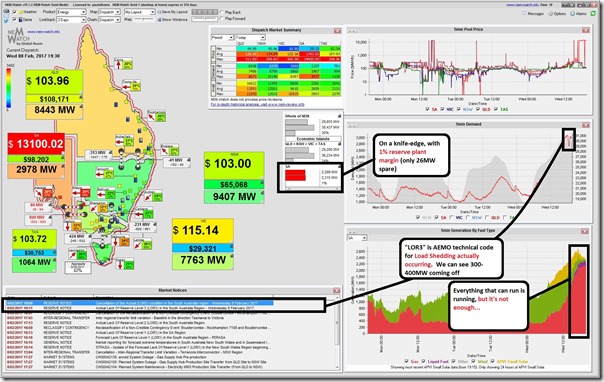It’s deja-vu all over again in South Australia this evening (Wed 8th February).
Following on from both:
1) The massive state-wide blackout on 28th September 2016; and
2) the smaller interruption that occurred on 1st December;
3) we see load shedding again.
Here’s a quick view of the whole of the NEM through NEM-Watch this evening at 19:30 NEM time (so 20:00 in Adelaide under daylight savings):
That’s not a misprint – it is reading a 1% instantaneous reserve plant margin (or only 26MW of spare capacity declared available for the 19:30 dispatch interval). That’s ludicrous.
As noted in the snapshot, gas-fired generation is supplying the lion’s share, with the liquid fuelled plants kicking in a bit, and wind doing what it can (albeit in the doldrums on a stinking hot day). Solar’s also faded into night. Thankfully, this time, the interconnections have held up.
When are we going to, collectively, stop treating the electricity sector as a political football, or ideologically-driven plaything at both ends of the Emotion-o-meter?
Matthew Warren wrote similarly in the AFR just yesterday.
Surely the South Australian’s deserve better. Politicians, of all flavours, should hang their heads in shame.



Pelican Point 50% mothballed still. That would have saved us this time. Fortunately the load shedding was less than an hour but it is disappointing we have available generation offline due to essentially a market failure in my view. (The most efficient gas generator unable to run economically)
“The most efficient gas generator unable to run economically”
You mean the price per kWh wasn’t high enough to turn Pelican Point on ?
High efficiency of a combined cycle plant is only useful if the plant runs as a baseload. With high renewable penetration in SA, a combined cycle plant would have to ramp-up and ramp-down to accommodate carbon-free energy from renewables. Such ramping-up/down would not allow a CCGT plant to operate at its most optimum leading to higher operating cost for the owner of the plant. No wonder, a highly efficient CCGT plant is not despatched by the owner in a market with high renewable penetration.
A reciprocating gas engine power plant is ideally suited for numerous start-stop, ramp-up/down application without impacting the maintenance cost and such a plant can also achieve high efficiency (46~47%). Such a plant can be built in 100MW chunks and allow efficient dispatch of just 10% of its capacity due to its multi-unit configuration.
I’ll be happy to provide more information.
Hi Suraj.
Great comment, where are you based and what is it you do?
Mark Yates
Mark/Ian/Suraj – will put you in touch with each other offline during the week to avoid the need to post contact details in open comments.
Hi Ian,
Quite keen to connect with people with similar interests in this field, would be great to talk further and understand what you do.
Mark Yates
Today 9/2/2017 17:00 in South Australia
Demand 2,824 MW
Generation 2,765 MW
Available Generation 2,660 MW
Imports from Victoria 567 MW
So SA generation plus imports from Victoria was 3,332 MW much higher than demand
Why is that? generation plus imports must always be equal to demand. What are the transmission losses?